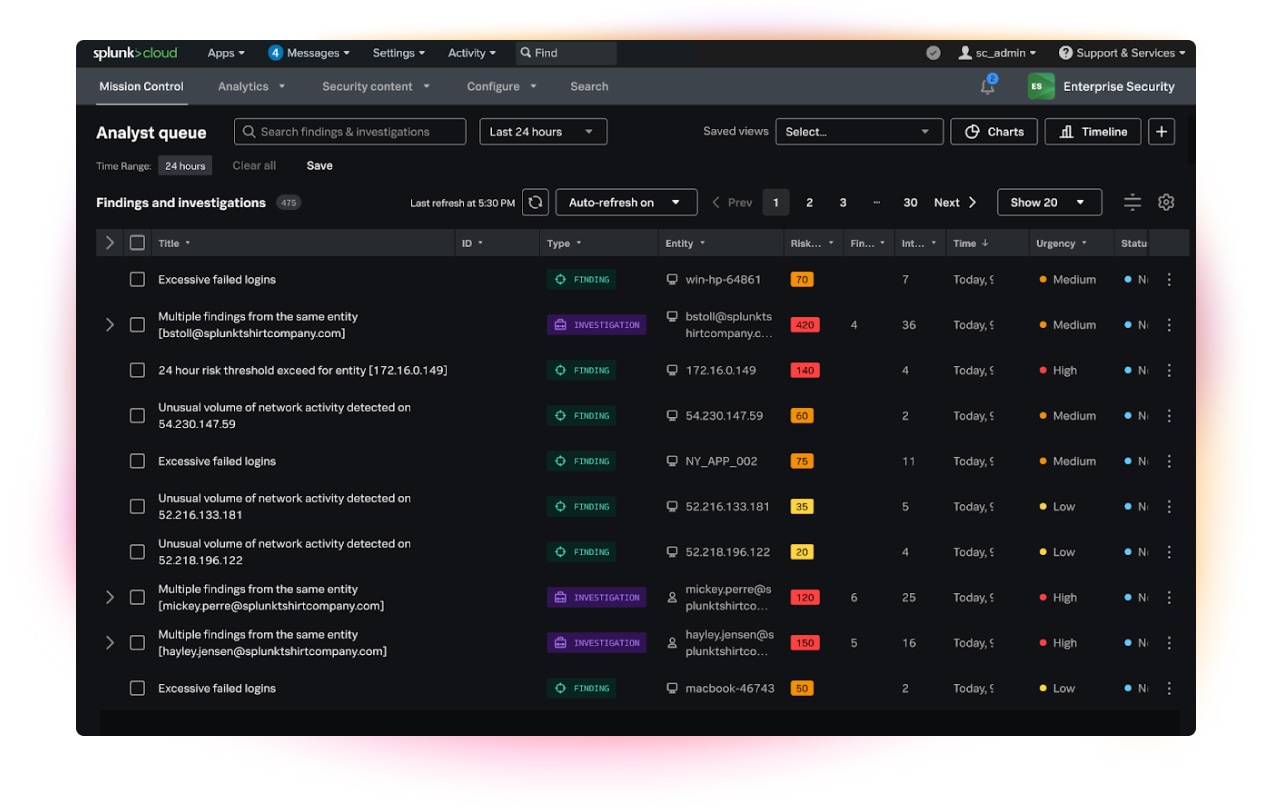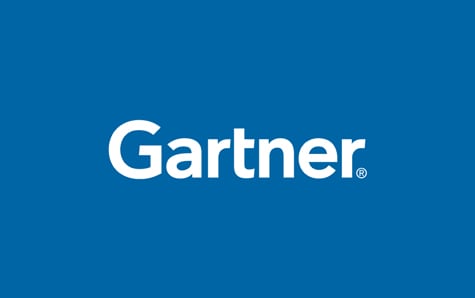Market-leading SIEM to quickly detect, investigate, and respond to threats.
Top 10 SIEM Use Cases Today: Real Examples and Business Value
Key takeaways
- Modern SIEMs provide end-to-end visibility across hybrid environments, laying the foundation for a modern, intelligence-driven SOC.
- AI-driven correlation and behavioral analytics enable faster threat detection and proactive response, helping reduce dwell time and prevent costly breaches.
- Automation and built-in compliance reporting lower operational overhead, increasing team efficiency and delivering long-term ROI on security investments.
SIEM platforms have become a cornerstone of modern security operations — pulling in log data from across your environment, surfacing threats, and helping teams respond fast. But what does that actually look like in practice?
From detecting real-time attacks to automating compliance reporting, SIEMs power a wide range of high-impact security use cases. In this article, we’ll walk through 10 of the most valuable ways organizations use SIEM every day — with real-world examples and key benefits for each.
Need a deeper dive into how SIEM works? Start with our SIEM explainer.
1. Normalize and aggregate logs for complete visibility
SIEMs collect and normalize logs from diverse systems (including firewalls, servers, applications, and endpoints, etc.) into a common format for efficient analysis. This normalization includes parsing timestamps, IPs, usernames, event IDs, and other critical fields into structured data.
Having a SIEM system enables strong awareness of activity across business systems and ensures that logs are being tracked should you require them for investigations.
Since all of the collection is handled in a singular interface, organizations are able to gather and normalize data easily. This enables powerful data analytics applications and supports data governance principles.
Example
Here’s how a SIEM normalizes logs across hybrid environments:
An organization uses a SIEM to ingest logs from Windows servers, Linux systems, network firewalls, and cloud environments (like AWS and Azure). The SIEM normalizes this data into a standardized schema, such as Common Event Format (CEF) or Log Event Extended Format (LEEF), allowing security analysts to query and correlate events more easily.
Benefits
This use case enables security teams to have:
- Centralized visibility across heterogeneous environments
- Simplified log ingestion and storage management
- Consistent and structured data for efficient analytics and compliance
2. Detect threats in real time and trigger intelligent alerts
SIEMs detect threats in real time by continuously monitoring logs with correlation rules, anomaly detection, and behavioral analytics, identifying patterns like:
- Brute-force attacks
- Malware infections
- Data exfiltration attempts
SIEM platforms can also counter threats with AI-based threat detection capabilities. To identify suspicious activity, SIEMs will analyze:
- Traffic trends
- Network usage patterns
- Security policies and rules
- Information access
- Modification privileges
Example
Here's what real-time threat detection can look like in action:
A correlation rule in a SIEM detects a failed login attempt followed by a successful login and subsequent privilege escalation on a critical server, all within five minutes. This sequence triggers a high-severity alert, prompting immediate investigation.
In another example, Children's National Hospital utilized Splunk Enterprise Security to detect 40% more threats compared to when a SIEM solution was not implemented.
Benefits
This use case enables:
- Early warning of ongoing or imminent security incidents
- Reduction in attacker dwell time before detection
- Enhanced situational awareness through dynamic alert dashboards
3. Automate compliance reporting and simplify auditing
SIEMs enable compliance reporting by generating audit reports and enforcing retention policies., as required by applicable regulatory frameworks. With SIEMs, the reporting process is easily automated and tracked.
Additionally, a SIEM solution stores logs in a central database, which makes forensic investigations fuss-free and transparent. These logs are a reliable way to demonstrate compliance with applicable regulations.
Example
Here’s how this use case looks in the real world:
A healthcare organization uses a SIEM to generate HIPAA-compliant reports that show:
- Access to electronic health records.
- Configuration changes on medical systems.
- Evidence of encryption in transit and at rest.
Benefits
This use case means teams across the business have:
- Automated evidence collection for audits
- Streamlined reporting for GDPR, PCI DSS, HIPAA, SOX, and other regulations
- Enhanced transparency and accountability
4. Monitor user behavior to detect anomalies and insider threats
SIEMs track user behavior to identify anomalies that may signify account compromise, data misuse, or policy violations. This includes monitoring:
- Login locations
- Access times
- Data transfers
- Administrative actions
Over time, modern SIEM solutions have developed more sophisticated features, including user behavior analytics (UBA) and entity behavior analytics (UEBA), to pick up deviations from the norm.
Example
Here’s an example of this user behavior monitoring:
A SIEM detects that an employee who typically accesses systems during 9 a.m. to 5 p.m. from a New York IP is now accessing a finance server at 3 a.m. from a foreign IP. This deviation from normal behavior triggers a medium-severity alert.
Benefits
This use case means security teams have access to:
- Improved accountability through session logging and audit trails
- Detection of suspicious user behavior patterns (UEBA)
- Early warning for insider threats or compromised credentials
5. Correlate long-term events to uncover advanced persistent threats
SIEMs detect advanced persistent threats (APTs) by correlating benign events into a broader threat picture. APTs are prolonged, well-coordinated, well-funded cyberattacks where undetected intruders steal sensitive data, usually with the goal of:
- Cyber espionage
- Hacktivism
- Financial gain
APT campaigns can unfold over weeks or months and consist of multiple stages: reconnaissance, initial access, lateral movement, and exfiltration. A robust SIEM solution should be able to correlate seemingly separate events to identify an APT intruder.
Example
Here’s how a risk-based alerting strategy plays out in practice:
A SIEM correlates unusual DNS queries, unauthorized access attempts to databases, and large outbound data transfers over non-standard ports — and plots them on a timeline. This timeline reveals a slow-moving APT attempting to exfiltrate sensitive intellectual property.
Benefits
This use case results in:
- Detection of sophisticated, multi-stage threats
- Greater protection for high-value targets
- Enhanced support for retrospective investigations and forensic timelines
6. Gain visibility into cloud environments and detect misconfigurations
Modern SIEMs integrate with cloud-native monitoring tools to provide unified visibility into cloud and hybrid environments.
More enterprise data is being entrusted to cloud environments, like those from the big 3, among countless others: AWS CloudTrail, Azure Security Center, Google Cloud Operations Suite. SIEMs with cloud integrations provide powerful monitoring capabilities of all logs stored in the cloud.
Example
A typical implementation might look like this:
The SIEM ingests AWS IAM access logs, S3 access logs, and Azure Activity Logs. It detects the creation of a new IAM user with administrator privileges during non-business hours, followed by access to sensitive S3 buckets.
Benefits
This use cases enables:
- Centralized monitoring of cloud workloads, assets, and identities
- Detection of misconfigurations and unauthorized access
- Support for shared responsibility models in cloud security

Splunk is an Industry Leader in SIEM
7. Proactively hunt for threats and streamline forensic investigations
Security teams use SIEMs for proactive threat hunting by querying logs, searching for indicators of compromise (IOCs), and identifying malicious patterns. This proactive approach extends the SIEM beyond passive alerting and event correlation.
Example
Here’s how threat hunting using SIEMs works:
A security analyst uses a SIEM to investigate connections to a suspicious IP address identified by a threat intel feed. The analyst uncovers a pattern of beaconing behavior from several endpoints, revealing a dormant command-and-control (C2) channel.
Benefits
With the threat hunting use case, security analysts now have:
- Enhanced detection capabilities beyond real-time alerts
- Accelerated incident response and containment
- Comprehensive post-incident investigations
8. Automate response workflows with SOAR integration
SIEMs have been known to integrate with security orchestration, automation, and response (SOAR) technology. SIEM-to-SOAR integrations mean playbooks can execute automatically in response to security alerts, enabling actions such as:
- Isolating a host.
- Disabling a user account.
- Enriching alerts with threat intel.
SIEMs typically do not have overlapping alerts with SOARs. This is by design: to ensure there isn’t alert fatigue. This reduces manual handling of alerts and therefore enables faster response time — security teams are now less overloaded with alerts and better able to address threats quickly.
Example
Here’s an example:
A SIEM detects signs of ransomware activity such as mass file encryption and registry modifications. The SOAR platform automatically isolates the affected machine from the network, sends notifications, and creates a case in the ticketing system.
Benefits
This use case offers tangible benefits like:
- Minimized response time and containment of threats
- Automated escalation workflows and routine tasks
- Reduced analyst fatigue and human error
9. Correlate endpoint activity with broader security signals
SIEMs provide better endpoint visibility by ingesting telemetry from EDR platforms. This enables the SIEM to correlate endpoint behavior with network and authentication data, providing more complete coverage.
Example
This example illustrates the use case:
A suspicious PowerShell process is detected by the EDR. The SIEM correlates this with unusual authentication attempts to critical systems, revealing a compromised endpoint being used for lateral movement.
Benefits
This use case enables:
- Holistic threat detection across varied platforms
- High-confidence alerts with contextual evidence
- Improved remediation through endpoint isolation
10. Track vendor access to reduce third-party risk
Organizations use SIEMs to monitor the activities of anyone who accesses internal systems, including external vendors, contractors, and partners. An important part of risk management, this ensures that third-party users comply with security policies.
Example
Here’s what this use case might look like:
The SIEM monitors VPN and SSH logins by third-party maintenance providers. Anomalous access from an unexpected geographic region or an unusual time of day triggers an alert.
Benefits
This use case gives the organization:
- Better oversight and understanding of vendor access
- Reduced exposure to supply chain attacks
- Improved contractual compliance and accountability
Sector-specific use cases for SIEM
The 10 use cases above can apply to practically any enterprise or organization. But what about SIEM in specific industries — how do they differ? Let’s look at some industry-specific applications for SIEM.
1. Financial services
SIEM empowers financial institutions to monitor high-value transactions as well as provide an easy way to access logs and audit trails for compliance. SIEMs have also seen use case in Fintech applications.
Here are some examples:
- Fraud detection: Monitor transactional anomalies such as high-value transfers, access from unusual geographies, or rapid logins across multiple accounts.
- Insider trading prevention: Correlate internal communications with trading patterns to detect violations.
- Regulatory compliance: Automate SOX and PCI DSS control monitoring, including audit trail generation and reporting.
Progressive Insurance used a SIEM tool, Splunk Enterprise Security, to protect $120 billion in market capitalization.
2. Healthcare
SIEM make it easy to better protect and monitor sensitive PII like personal identifiers and highly confidential medical information in healthcare. Here are some examples:
- Patient record monitoring: Detect unauthorized access to EHRs and PHI.
- Medical device misuse: Identify unusual patterns from connected IoT medical devices.
- HIPAA compliance: Maintain logs of data access and changes for audit readiness.
3. Manufacturing
Manufacturing can benefit from SIEM solutions, especially with automating surveillance and collecting logs from logistics activities. Here are some examples:
- ICS security: Monitor access and configuration changes in SCADA systems and PLCs.
- IoT device surveillance: Detect rogue devices or anomalous communication patterns.
- IP protection: Track access to CAD files, production blueprints, and R&D data.
4. Government and public sector
Government and public-sector agencies can benefit from SIEM solutions, with a focus on monitoring access to classified information and state secrets. This is crucial in protecting national security and its assets.
Here are some examples:
- National threat monitoring: Integrate SIEM with national CERT data for real-time threat intel.
- Classified access auditing: Monitor logins to classified systems and file accesses.
- FISMA/NIST compliance: Automate control assessments and incident tracking.
Modern SIEMs support modern security operations
SIEM platforms have become indispensable and are used widely across various industries. The potential that SIEMs bring continues to rise as more organizations integrate them with other platforms like SOARs and EDR platforms.
Start protecting your organization with SIEMs to bolster your threat detection and overall monitoring measures today. Get started with this free product tour of Splunk Enterprise Security.
FAQs about SIEM Use Cases
Common SIEM use cases include log aggregation, threat detection, compliance reporting, insider threat monitoring, and cloud visibility.
SIEM platforms use correlation rules, anomaly detection, and behavioral analytics to identify suspicious patterns and trigger real-time alerts.
Yes, SIEMs automate compliance reporting and audit trails for regulations like HIPAA, PCI DSS, GDPR, and SOX.
Modern SIEMs incorporate cloud-native capabilities, AI-driven analytics, and support for dynamic environments like SaaS, containers, and hybrid clouds.
By correlating behavior patterns, monitoring privileged access, and applying UEBA, SIEMs can detect unusual internal activity that may signal insider threats.
See an error or have a suggestion? Please let us know by emailing splunkblogs@cisco.com.
This posting does not necessarily represent Splunk's position, strategies or opinion.
Related Articles
About Splunk
The world’s leading organizations rely on Splunk, a Cisco company, to continuously strengthen digital resilience with our unified security and observability platform, powered by industry-leading AI.
Our customers trust Splunk’s award-winning security and observability solutions to secure and improve the reliability of their complex digital environments, at any scale.



